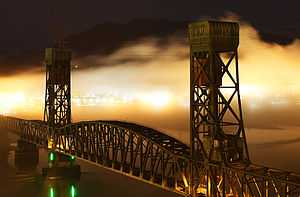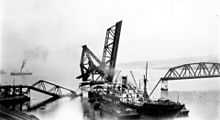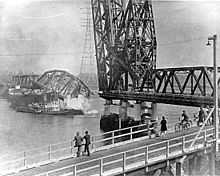Second Narrows Bridge

The Second Narrows Rail Bridge is a vertical lift railway bridge that crosses the Burrard Inlet and connects Vancouver with the North Shore. As the name suggests, it is located at the second narrowing of the Burrard Inlet.
The original Second Narrows Bridge was constructed in 1925, and was the first bridge to connect Vancouver with the North Shore over the tidal bore of the narrows. This bridge was constructed, by John Stewart and Northern Construction, with a car deck and a year later in 1926 trains began using the bridge as well. After being hit by a number of ships and being out of service for 4 years, in 1933 the provincial government bought the bridge and installed a lift section of the deck.
In 1960 a new much larger (350 m, 1,150 ft, span) and higher 6 highway lane Second Narrows Bridge was completed alongside the original bridge, and the original bridge was converted exclusively for rail use. In 1994 the new road bridge was renamed the Ironworkers Memorial Second Narrows Crossing in honor of the ironworkers who died in accidents while building it. However, the new bridge is still commonly referred to as the Second Narrows Bridge.
The 1926 railbridge was replaced in 1969 by CN Rail with a larger, higher lift bridge. A bridgetender activates cables and counterweights to raise the span. Unless moving a train across the Burrard inlet, the lift section is always in the up position to allow ships to go underneath. The Lions' Gate Bridge spans the first narrows of Burrard Inlet.
The current CN Second Narrows railway bridge has a vertical clearance of 46 meter at the main lift span fully raised (open position). The vertical lift section of the Second Narrows Railway Bridge provides 137 meters clear navigation width between rubbing fenders. However, the Ironworkers Second Narrows road bridge has a vertical clearance of 44 meters and the shipping channel where the maximum vertical clearance is available is 110 metres wide.
Background
Amid the hullaballoo of the Klondike Gold Rush were schemes to build a railway from Vancouver to the Dawson gold fields. Of course the first stage in this would be to bridge Burrard Inlet and then build a railway north. John Hendry floated the Vancouver, Westminster, and Yukon Railway which built a line from Ladner to Westminster and then to Vancouver via Burnaby Lake. This line was paired with the Great Northern Railway who also wanted trackage into Vancouver.
In the process, various other railroads all became involved in the bridging scheme: the Canadian Northern Railway, Milwaukee Road, and the Pacific Great Eastern Railway. The bridge itself would be owned by the Federal Government as they had control of harbours and shipping, and would lease access to the railways as they did with the rail bridge in New Westminster. One of the main reasons was that there was very little space on the south shore for wharves, thus railways wanted to develop the North Shore. The south side was occupied by another railway. A company was floated, the Burrard Inlet Bridge and Tunnel Company, and contracts were issued to span the tidal bore. A one-point, a causeway was planned to dam the narrows and create bridges and wharves that way.
Alas, World War I intervened, as did the bankruptcy of all the interested railways. With it went dreams of the bridge and rails up Indian Arm, Capilano, or Howe Sound. However, the predecessor railways did sign contracts to build a bridge and a new Hotel Vancouver. Only after the war with huge increase in funding to improve harbours around the British Empire, partly due to problems associated with wartime shipping, did funds appear for the completion of the 1925 bridge. And so the north shore port became an amalgam of operations with Canadian National, Pacific Great Eastern and Harbour and Wharves Commission all using the bridge when it was not out of service. North Vancouver ferries operated at this time as well.
The essential wartime shipyards in North Vancouver, underscored the need for reliable industrial access. Further, the expansion of Lynnterm, Wheat elevators, coal and the sulphur port in the 1960s indicated the growing use of the North Shore.
Chronology of the original bridge



- 1902 V. W. and Y Railway completed to Burnaby. Bridge Planned.
- 1910 Burrard Inlet Bridge and Tunnel Company plans floated.
- 1912 Land speculation on North Shore, subject to completion of bridge.
- 1914 Railway to Deep Cove and Port Moody planned.
- 1915 Market Collapse; P. G. E Railway bankrupt.
- 1916 Causeway planned; Canadian Northern bankrupt.
- 1925: A smaller, lower bridge is completed, than originally envisioned.
- 1926: Trains began using the bridge.
- 1927: A 10,000 ton freighter, the Eurana hit it on March 10 causing almost $80,000 worth of damage.
- 1928: Hit by the SS Norwich City.
- 1930: The Losmar hits the south span.
- 1930: On September 13, the barge Pacific Gatherer becomes wedged under the bridge’s fixed centre span. The tide rose pushing the barge up under the span, knocking it off its supports. The span hung off one side before suddenly breaking free and sinking into the depths of Burrard Inlet. Lawsuits and the bankruptcy of the Bridge company delayed any attempt at repairs. The bridge remained closed for four years.
- 1933: Sold to the Provincial government. Repairs began.
- 1934: Reopened, replacing the bascule with a centre lift span.
- 1963: Closed to highway traffic and sold to the CNR for $1.
- 1968: New, larger lift bridge is built immediately to the east of the 1926 Bridge.
- 1969: Thornton Tunnel is dug for CN trains to connect with line at Willingdon.
- 1970: Old 1926 bridge is removed, as are cement piers.
- 1979: October, Japanese freighter "Japan Erica" carrying logs collides with the bridge in heavy fog knocking a section of the bridge just north of the lift span into the water. The bridge is closed until March 4, 1980.
See also
External links
| Wikimedia Commons has media related to Second Narrows Bridge. |
- A Short History of the Second Narrows Bridge
- Satellite image of the Ironworkers Memorial Second Narrows Crossing and Second Narrows Bridge
- 1979 collision description and photos in Canadian Rail No. 344, 1980
| |||||||||
Coordinates: 49°17′41″N 123°01′28″W / 49.294638°N 123.024484°W